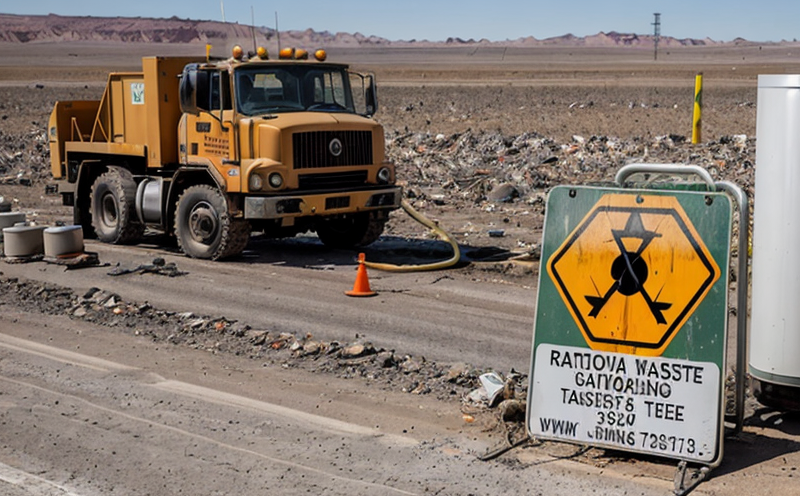ISO 18589-6 Radiochemical Determination of Radium Isotopes
The ISO 18589 series provides a comprehensive set of methods for the radiochemical determination of radium isotopes, specifically targeting Ra224, Ra226, and Ra228. This service focuses on the ISO 18589-6 method, which is widely recognized for its accuracy and precision in measuring these isotopes. The process involves intricate sample preparation followed by a multi-step radiochemical separation and counting procedure.
Radium isotopes are crucial in various sectors such as nuclear medicine, environmental monitoring, and waste management due to their significant radiological properties. The accurate determination of radium isotopes is essential for ensuring safety standards are met across different industries.
The ISO 18589-6 method employs a combination of solvent extraction techniques and liquid scintillation counting (LSC) to achieve this precision. This approach ensures that even minute quantities of radium can be detected with high accuracy, making it ideal for both research and regulatory compliance.
The testing procedure begins with the collection and preparation of the sample, which may include leaching or dissolution steps depending on the matrix type (e.g., soil, concrete). After thorough purification through solvent extraction, the separated radium is then counted using a high-purity germanium (HPGe) detector for Ra226, and LSC for both Ra224 and Ra228. The results are reported according to the specified limits of detection (LoD) outlined in ISO 18589-6.
The method is designed to ensure that all stages of the process, from sample preparation through final counting, adhere strictly to international standards. This ensures consistency and reliability across different laboratories performing these determinations.
For accurate results, it's important to note that the choice of solvent extraction reagents plays a critical role in minimizing interferences and achieving optimal separation efficiency. The use of appropriate scintillation cocktails is also crucial for obtaining reliable LSC counts.
The ISO 18589-6 method offers several advantages over other analytical techniques due to its high sensitivity, selectivity, and capability to handle a wide range of sample types. It's particularly suited for complex matrices like sediments or biosolids where multiple isotopes need simultaneous quantification.
Accurate radium isotope determination can help in assessing the radiological impact on the environment, ensuring compliance with regulatory limits set by agencies such as the International Atomic Energy Agency (IAEA) and national standards organizations. This information is vital for industries involved in nuclear fuel cycle operations or waste disposal activities.
Industry Applications
| Application | Description |
|---|---|
| Nuclear Fuel Cycle | Determining radium isotopes aids in understanding the behavior of spent fuel and its potential impact on the environment. |
| Sewage Treatment Plants | Monitoring radium levels helps assess the effectiveness of treatment processes and ensure compliance with regulatory standards. |
| Environmental Monitoring | Measuring radium isotopes allows for accurate assessment of soil, water, and air contamination levels. |
| Nuclear Medicine | Determining the purity of radionuclides used in medical treatments ensures patient safety and efficacy. |
These applications highlight how ISO 18589-6 is integral to various sectors, providing critical data for decision-making processes related to radiation safety and environmental protection. The precise measurements obtained through this method are indispensable in ensuring compliance with international standards and local regulations.
Quality and Reliability Assurance
- High-Purity Standards: Use of high-purity reagents to minimize interference and ensure accurate results.
- Safety Protocols: Strict adherence to safety guidelines during sample preparation and handling.
- Calibration Procedures: Regular calibration checks for all analytical equipment used in the process.
- Data Validation: Cross-checking results against known reference materials using inter-laboratory comparisons.
The rigorous quality assurance measures implemented ensure that every test conducted meets stringent accuracy and precision standards. This commitment to excellence guarantees reliable data, which is crucial for making informed decisions in radiation management.
Competitive Advantage and Market Impact
Accurate radium isotopes determination using ISO 18589-6 can provide significant competitive advantages by ensuring compliance with stringent regulatory requirements. Industries involved in nuclear fuel cycle operations, waste disposal activities, and environmental monitoring stand to gain from the precise data obtained through this method.
By adhering strictly to international standards, laboratories offering this service position themselves as leaders in radiation safety and environmental protection. This reputation enhances their market standing and credibility among clients and regulatory bodies alike. The ability to provide accurate and reliable results fosters trust within the industry, leading to increased business opportunities and partnerships.
In addition, compliance with ISO 18589-6 can help organizations avoid costly penalties associated with non-compliance and enhance their reputation for environmental responsibility. This service not only supports regulatory adherence but also contributes positively towards sustainability goals by providing robust data for informed decision-making processes.





